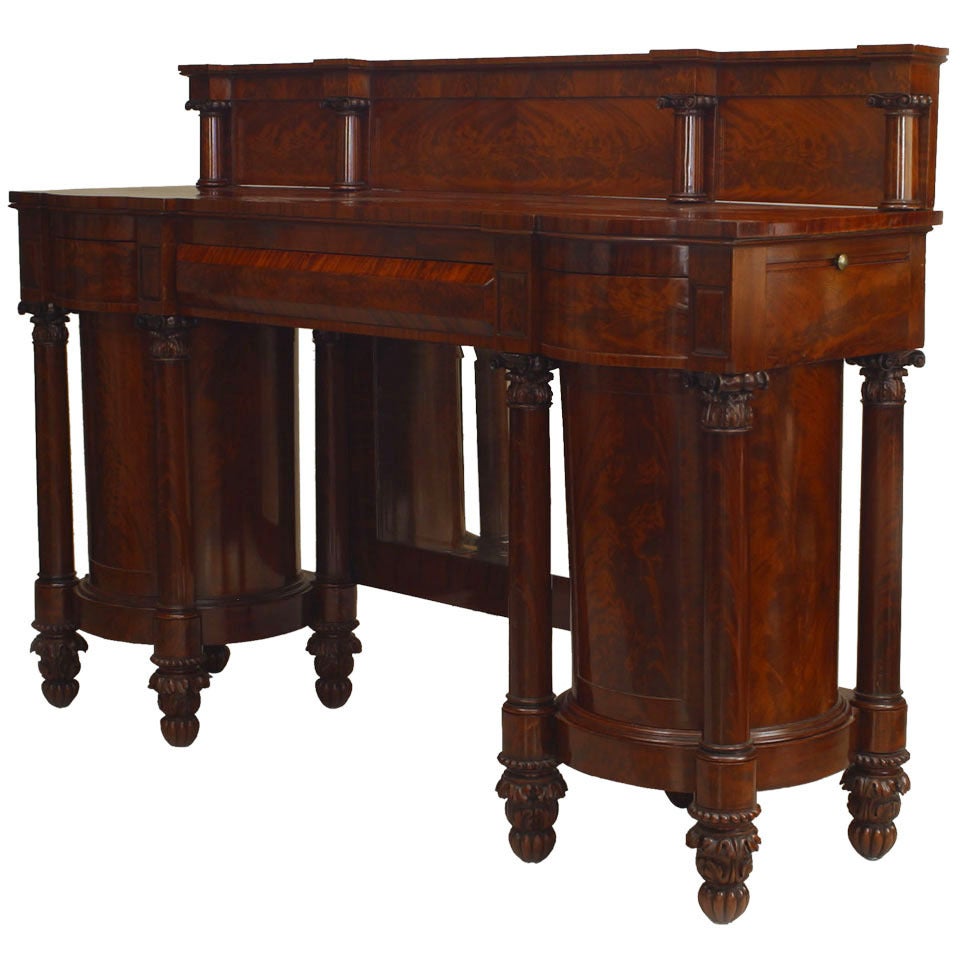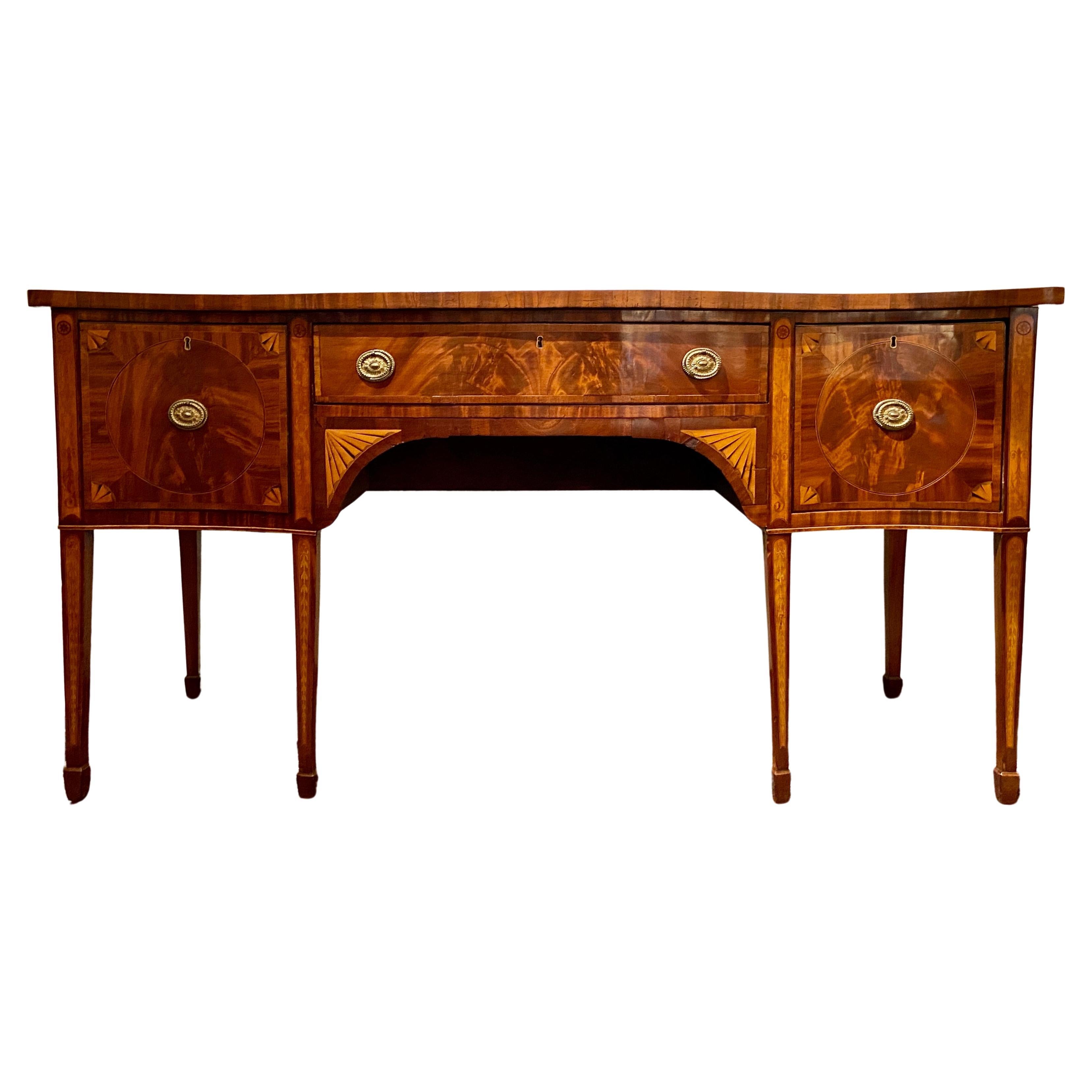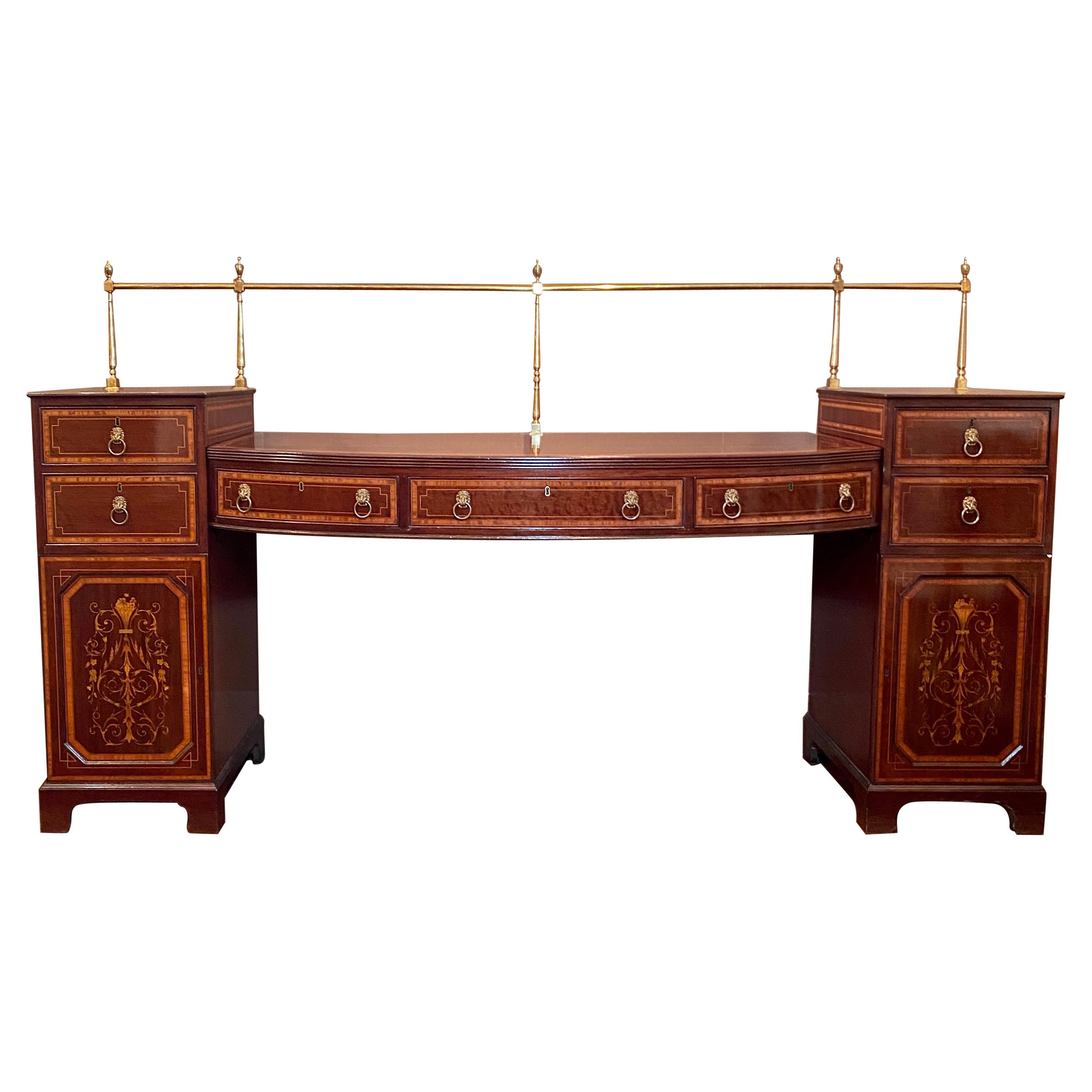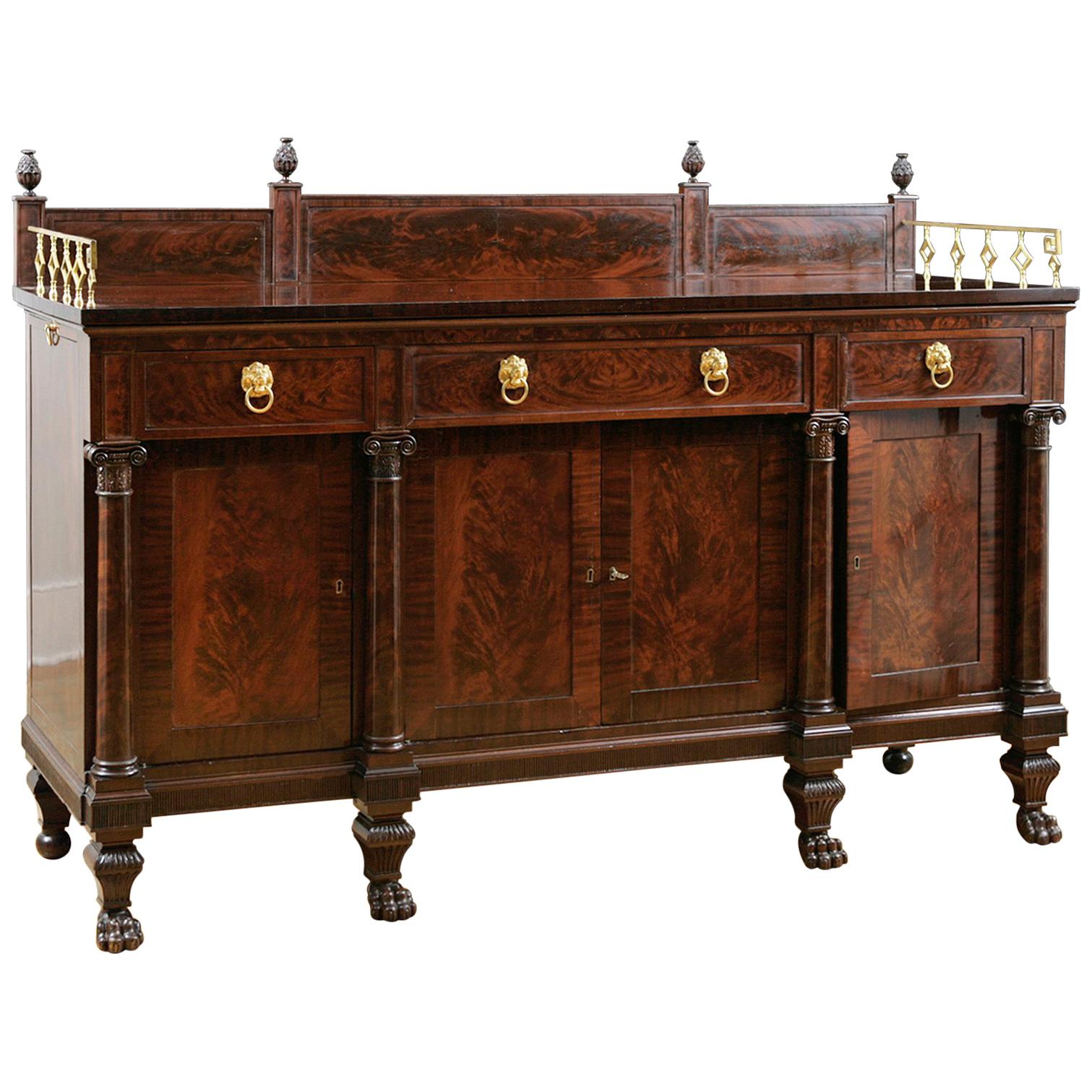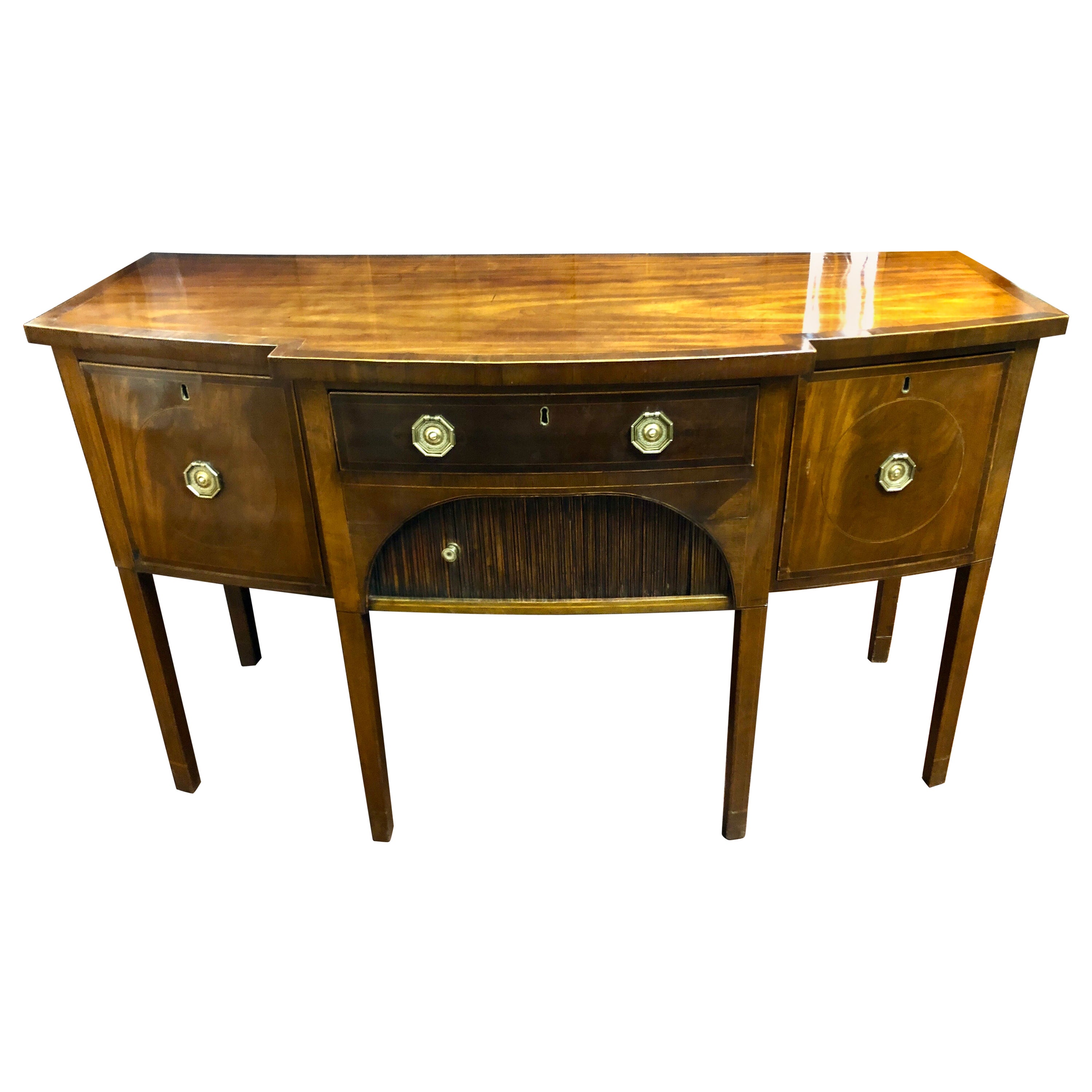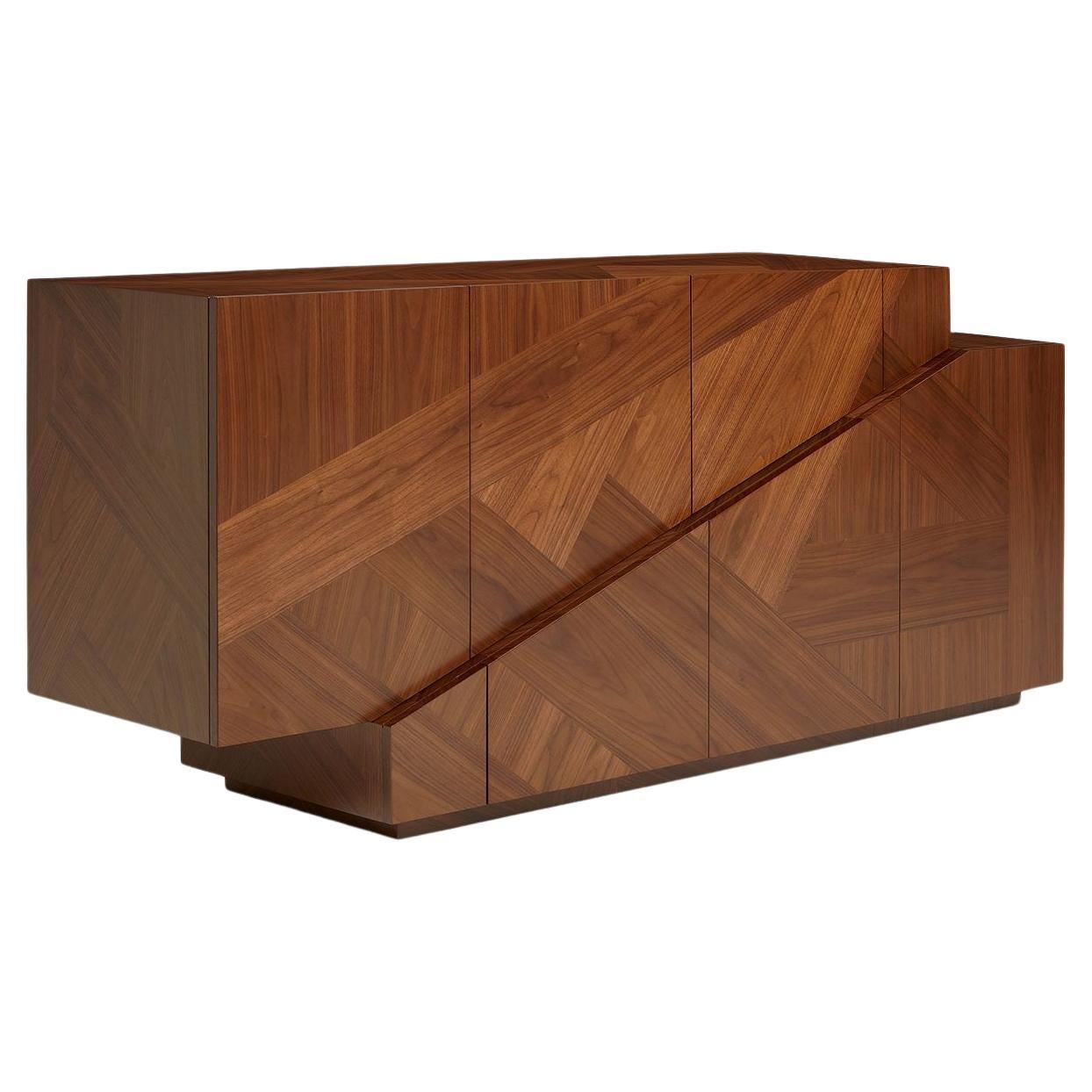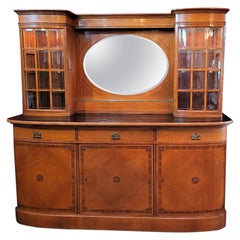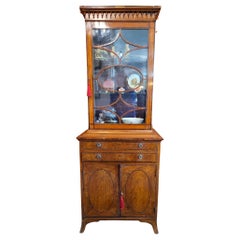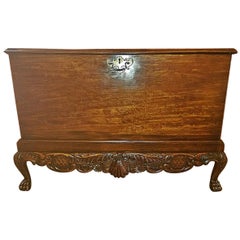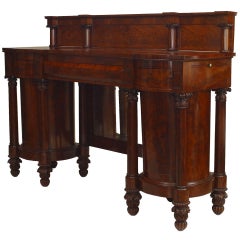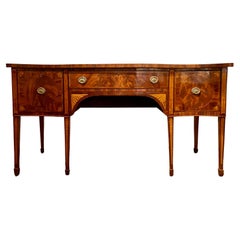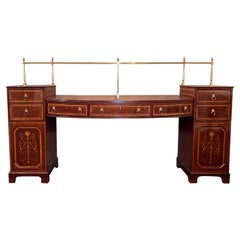Items Similar to Late 18C American Sheraton Sideboard by Duncan Phyfe - Important
Want more images or videos?
Request additional images or videos from the seller
1 of 21
Late 18C American Sheraton Sideboard by Duncan Phyfe - Important
About the Item
We have the pleasure to present to you a STUNNING and IMPORTANT Late 18th century American Sheraton Sideboard, made circa 1788/89, in New York by the famous Duncan Phyfe.
Signed/Marked and dated on the base of the front of the middle drawer (See Pics).
We are confident that the bottom mark is – “DJ Fife & Co” – The “D”, “… Fe & Co” are clearly visible and above it to the right looks like a signature – ‘D Fife’ and ‘1788/9’.
On his 20th Birthday, Phyfe's mother, gave him "The Cabinetmaker & Upholsterer's Drawing Book in Four Parts 1788" by Thomas Sheridan. This had a profound impact on Phyfe's understanding of the basic geometry, the purity of form and refinement of structural dimensions to cabinet making.
Sheraton's Book taught the young Scotsman to reject the florid and OTT ornament of the dying European Kings and adopt simpler lines.
In a few years he opened his own shop in Albany, NY and used Sheraton's designs.
The quality of this piece, is 'classic' Duncan (Fife) Phyfe during his early homage to Thomas Sheraton.
What makes this piece even MORE IMPORTANT is the date, which is either 1788 or 1789 which means that Phyfe was only 20 or 21 years of age when he made this and therefore it is one of his very EARLIEST pieces!!!
It is of exceptional construction, craftsmanship and style to identify it as a piece of American Sheraton. The combination of woods and veneers tells us this also. The front is mahogany veneer with satinwood herringbone stringing and satinwood/tulipwood escutcheons. The secondary woods are walnut, cheery and birch.
This piece features finely case brass handles with a thistle motif, the national flower and emblem of Duncan Phyfe's home country of Scotland.
It also has 2 swinging doors on either side which open to reveal shelving and the 2 central doors likewise.
The front is serpentine in shape and form with each door of a convex nature.
It sits on 8 fluted and graduating legs with the front 4 reflecting the satinwood stringing and banding of the upper portion.
We recently had some of the locks serviced (and keys made) by a professional locksmith who informed us that the locks were original Early American locks and he has rarely seen others like them. This again, helps us in authenticating the age of the piece!
Duncan Phyfe (1768 – 16 August 1854) was one of nineteenth-century America’s leading cabinetmakers.
Although he did not create any new furniture style, he interpreted fashionable European trends in a manner so distinguished and particular that he became a major spokesman for Neoclassicism in the United States, influencing a whole generation of American cabinetmakers.
Born Duncan Fife near Loch Fannich, Scotland, he immigrated with his family to Albany, New York, in 1784 and served as a cabinetmaker’s apprentice.
In 1791 he moved to New York City and one year later is documented the earliest mention of him in the city, when he was elected to the General Society of Mechanics and Tradesmen, sponsored by Isaac Nichols and Seabury Champlin, either of whom may have trained him.
By the time of his marriage in 1793, he appears in the New York directories as a “joiner,” but by 1794 he called himself “cabinetmaker” and had changed the spelling of his name to Phyfe. He opened his own business in 1794 and was listed as a cabinetmaker in the New York Directory and Register. From his first shop on 2 Broad Street, he later moved to Partition Street (later renamed Fulton Street in 1817 in honor of Robert Fulton), where he stayed for the rest of his life.
A poor immigrant when he arrived in America from his native Scotland, Phyfe acquired wealth and fame through hard work, exceptional talent and the support of patrons. He would come to count among his clients some of the nation’s wealthiest and most storied families. Throughout the first half of the nineteenth century he made Neoclassical furniture for the social and mercantile elite of New York, Philadelphia, and the American South where he was particularly popular. Known during his lifetime as the “United States Rage”, to this day remains America’s best-known cabinetmaker. Establishing his reputation as a purveyor of luxury by designing high-quality furniture.
His personal style, characterized by superior proportions, balance, symmetry, and restraint, became the New York local style. Many apprentices and journeymen exposed to this distinctive style by serving a stint in the Phyfe shop or by copying the master cabinetmaker’s designs helped to create and sustain this local school of cabinetmaking. Demand for Phyfe’s work reached its peak between 1805 and 1820, although he remained a dominant figure in the trade until 1847, when he retired at the age of seventy-seven. Within the short span of a single generation, however, the work of the master was all but forgotten until the revival in the 1920s, when different furniture companies replicated his designs for several decades.
He became known as one of America’s leading cabinetmakers by selling furniture at relatively low prices. Phyfe’s work encompassed a broad range of the period’s Neoclassical styles, starting from his earliest furnitures— which bear the influence of his 18th-century British predecessors Thomas Sheraton and Thomas Hope— continuing with Regency, Federal, Empire and ending with his late simplified designs in the Grecian plain style.
On 15 October 1922, the Metropolitan Museum of Art opened to the public “Furniture from the Workshop of Duncan Phyfe”, the first exhibition ever held in an art museum on the work of a single cabinetmaker. Ninety years later and only for the second time in history, a major retrospective on this iconic American craftsman and his furniture was again on view from 20 December 2011 – 6 May 2012, under the title “Duncan Phyfe: Master Cabinetmaker in New York”.
Another exhibition took place at the Museum of Fine Arts, Houston from 24 June – 9 September 2012.
Duncan Phyfe’s furniture can be admired in the White House Green Room, Edgewater, Roper House and especially at Millford Plantation, owned by the Classical American Homes Preservation Trust. His furniture appears in many museums and private collections as well.
- Dimensions:Height: 41.2 in (104.65 cm)Width: 68.75 in (174.63 cm)Depth: 24.25 in (61.6 cm)
- Style:Sheraton (Of the Period)
- Materials and Techniques:
- Place of Origin:
- Period:
- Date of Manufacture:circa 1789
- Condition:Wear consistent with age and use. Minor losses. Very good for it’s age. Some minor losses of veneer (chips) but nothing serious. 2 of the internal base shelves are replacements. Has keys. Crack on the top, but does not detract from the piece.
- Seller Location:Dallas, TX
- Reference Number:1stDibs: LU3978122123752
About the Seller
4.9
Platinum Seller
Premium sellers with a 4.7+ rating and 24-hour response times
Established in 2015
1stDibs seller since 2018
387 sales on 1stDibs
Typical response time: 1 hour
- ShippingRetrieving quote...Shipping from: Dallas, TX
- Return Policy
Authenticity Guarantee
In the unlikely event there’s an issue with an item’s authenticity, contact us within 1 year for a full refund. DetailsMoney-Back Guarantee
If your item is not as described, is damaged in transit, or does not arrive, contact us within 7 days for a full refund. Details24-Hour Cancellation
You have a 24-hour grace period in which to reconsider your purchase, with no questions asked.Vetted Professional Sellers
Our world-class sellers must adhere to strict standards for service and quality, maintaining the integrity of our listings.Price-Match Guarantee
If you find that a seller listed the same item for a lower price elsewhere, we’ll match it.Trusted Global Delivery
Our best-in-class carrier network provides specialized shipping options worldwide, including custom delivery.More From This Seller
View AllArt Deco Portois and Fix Viennese Buffet Sideboard
By Portois & Fix
Located in Dallas, TX
Presenting an amazingly rare piece of Art Deco furniture by an exceptionally rare maker, namely, an Art Deco Portois and Fix Viennese buffet sideboard.
Part of a complete Dining Room Set comprising of 3 pieces – this Buffet/Sideboard, Tall Case Clock ands Credenza. All in our Inventory but being sold separately (or together if you have a desire to own the complete set which you will NEVER be in a position to do again).
Made in Vienna, Austria circa 1920-30 by the famous furniture maker of Portois & Fix.
The piece consists of a Buffet or Sideboard with glass display pillars...
Category
Early 20th Century Austrian Art Deco Sideboards
Materials
Brass
18C Irish Sheraton Satinwood Display Cabinet
Located in Dallas, TX
PRESENTING AN EXCEPTIONAL AND RARE 18C Irish Sheraton Satinwood Display Cabinet of GORGEOUS neat ‘diminutive’ proportions, from circa 1780-1800.
Made of beautifully naturally patina...
Category
Antique Late 18th Century English Sheraton Cabinets
Materials
Mahogany, Satinwood
Early 19th Century English Chiffonier in the Manner of Gillows
By Gillows of Lancaster & London
Located in Dallas, TX
Presenting an absolutely gorgeous early 19th century English chiffonier or breakfast buffet, most likely, from the renowned maker of Gillows of Lancas...
Category
Antique Early 19th Century English Regency Buffets
Materials
Brass
18C Irish George II Mahogany Silver Chest on Exceptional Carved Stand
Located in Dallas, TX
PRESENTING AN ‘ABOLUTELY STUNNING’ PIECE OF IRISH FURNITURE HISTORY, namely, an 18C Irish George II Mahogany Silver Chest on the most amazing and EXCEPTIONAL Carved Stand.
Made circa 1745, by an obviously ‘top quality’ Irish Georgian furniture...
Category
Antique Mid-18th Century Irish George II Blanket Chests
Materials
Mahogany
$32,000 Sale Price
28% Off
18th Century Irish Georgian Cork Sideboard
Located in Dallas, TX
Presenting a gorgeous and very rare 18th century Irish Georgian Cork Sideboard of lovely neat proportions.
Made in Ireland during the George III Era, circa 1790 and most likely made in the Southern City of Cork.
A STUNNING Irish provincial piece from the Georgian Era!
Made of solid mahogany, probably imported from Cuba and the secondary woods are oak (as one would expect). Beautiful dovetailing on the inside of the drawers.
The ‘hints’ that this is in fact an ‘Irish’ piece are numerous. The ‘scallop shell’ on the center of the back gallery is unmistakably an Irish Georgian signature. The scalloped fans beneath either side of the central drawer are likewise an Irish signal. The shape, design and style is entirely consistent with similar pieces made in Cork at the end of the 18th Century.
It has it’s original brasses which is fantastic. Lions Head Ring drawer pulls and stunning urn keyhole covers/escutheons.
It has a solid gallery back splat (with central Scallop) and on both sides this ends in curved and carved scroll ends. Beneath the back splat their is a grooved plank section for holding plates etc upright.
The server/counter top area is edged and banded with a carved rope style edging.
The mid section consists of 3 drawers and 2 doors.
The piece sits on 6 legs 4 to the front and 2 to the rear. The front legs are pillars starting at the top with an acanthus style scroll … extending down to another scroll carving directly above the reeded and fluted legs. The 2 rear legs do not have the same fluting detail.
The 2 side doors open to reveal a simple one shelf storage area. One probably held a lead lined cellarette at one time.
The piece is in excellent condition for it’s age and use. There are some minor aging cracks on the counter top on the left hand side. A small loss of molding to the right lower door. No original keys but we are getting replacements made.
Bought in Surrey, England in 1999 by a Private Texas Collector and shipped to Texas. We have the original ‘sales invoice’ and the dealer sold it as a “Regency Mahogany Sideboard circa 1820’and told her that it was an English piece, for the sum of 3,400 GBP. Not only did the dealer not recognize the obvious ‘Irish’ signs...
Category
Antique Late 18th Century Irish George III Buffets
Materials
Mahogany, Oak
Early 20C Exceptional Chippendale Irish Georgian Style Sideboard by S Hille
By Salomon Hille
Located in Dallas, TX
Presenting an amazing early 20th century Exceptional Chippendale Irish Georgian style sideboard by Salamon Hille.
This piece is simply Magnif...
Category
Early 20th Century English Chippendale Buffets
Materials
Mahogany
You May Also Like
Duncan Phyfe American Empire Mahogany Sideboard
By Duncan Phyfe
Located in Queens, NY
American Empire mahogany sideboard with two pedestal cabinets and 4 carved column supports centering a lower mirror under 3 drawers ...
Category
Antique Late 18th Century American Empire Sideboards
Materials
Mahogany, Mirror
Antique English Sheraton Mahogany Sideboard, Circa 1780-1810
Located in New Orleans, LA
Antique English Sheraton Mahogany sideboard, Circa 1780-1810.
Serpentine front and beautiful Inlay.
Category
Antique Late 18th Century English Sheraton Sideboards
Materials
Mahogany
Antique English Sheraton Inlaid Mahogany Sideboard With Brass Rail, Circa 1870's
Located in New Orleans, LA
Exceptional Antique English Sheraton Finely Inlaid Mahogany Sideboard With Brass Rail, Circa 1870-1880. Signed Edwards & Roberts
Ra...
Category
Antique 19th Century English Sheraton Sideboards
Materials
Mahogany
American "French Sideboard" Attributable to Duncan Phyfe, New York, circa 1815
By Duncan Phyfe
Located in Miami, FL
An exceptionally fine and rare "French Sideboard Table" in mahogany, attributable to the workshop of the eminent New York cabinetmaker, Duncan Phyfe, circa 1810-1818.
This exquisit...
Category
Antique Early 19th Century American Federal Sideboards
Materials
Brass
Late 18th C. English Inlaid Mahogany Hepplewhite Style Shaped Front Sideboard
By George Hepplewhite
Located in CHARLESTON, SC
A wonderful, rare period Geo. III late 18th/early 19th century inlaid mahogany sideboard with its original tambour ribbed, slid...
Category
Antique 1790s English George III Sideboards
Materials
Boxwood, Mahogany
Marquetry Sideboard in American Walnut Veneer
By Ginger & Jagger
Located in NEW YORK, NY
This sideboard is a contemplation on the polarities in nature. North and south, earth and water, gravity and air, these poles coexist with seemingly impossible harmony. Intricate in ...
Category
2010s Portuguese Modern Sideboards
Materials
Wood, Walnut
$23,100 / item
Recently Viewed
View AllMore Ways To Browse
Used American Signature Furniture
Late 18th Century American
American Arts And Crafts Motifs
Fluted Veneer
Used Duncan Furniture
American Trade Signs
18th Century Sheraton Furniture
Sheraton Mahogany Brass
National Cabinet Company
Thomas Sheraton
American Classical Mahogany
Duncan Antique Furniture
Scottish Arts And Crafts Furniture
Antique Furniture Directory
Scottish Arts Crafts
Antique Purveyor Furniture
Used Furniture Albany
18th Century Federal Furniture
